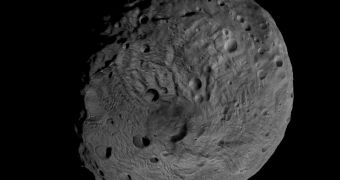Eager to make the most of Dawn mission to the large asteroid Vesta, mission controllers at the NASA Jet Propulsion Laboratory (JPL), in Pasadena, California, are putting the spacecraft through its paces. Over the past few weeks, the probe has snapped a large numbers of photos depicting the space rock.
The reason why this object is so important is that it may very well be a failed protoplanet, a cosmic body that was supposed to evolve into a Mars-sized planet. However, during the early days of the solar system, a chain of events conspired to prevent it from growing.
Through the NASA Dawn mission, astronomers hope to be able to infer exactly what caused this phenomenon. They are also very interested in knowing more about the object's inner structure, which they say could reveal many details of planetary evolution.
The space probe reached Vesta on July 16, achieving orbital insertion seamlessly thanks to its ion engines. It is scheduled to survey the largest asteroid in our solar system from four different science orbits. It now occupies the first such orbit.
This new batch of photos that the JPL team released were collected from a vantage point about 1,700 miles (2,700 kilometers) above the surface. The probe used its framing cameras to get the best possible angles on structures investigators were interested in.
Vesta has a number of striking features, and scientists hope that the spacecraft's one-year mission will be sufficient to unlock at least some of them. Dawn is scheduled to depart in July 2012, making its way to a February 2015 arrival at the dwarf planet Ceres.
Its primary mission will end in July 2015, after 6 months of operations at Ceres. If the situation allows for it, the science mission will be extended even further, allowing more data to be collected on this interesting dwarf planet, which lies between the orbits of Jupiter and Mars.
Until then, the probe will be focusing on the second-largest object in the Inner Asteroid Belt. Already, astronomers determine that winter has come to Vesta's northern hemisphere, which is not in perpetual darkness, similar to our North Pole's 6-month nights.
A South Pole-focused view of the asteroid shows that half of it is dark, whereas the other half is illuminated. This happens simply because half of the asteroid experiences day. Dawn was able to study these phenomena, as well as some of the largest craters on the asteroid, in just two months.
“Another distinct feature […] is a massive circular structure in the south pole region. The circular structure, or depression, is several hundreds of miles, or kilometers, wide, with cliffs that are also several miles high,” a JPL press release accompanying the batch of photos indicates.
“One impressive mountain in the center of the depression rises approximately 9 miles (15 kilometers) above the base of this depression, making it one of the highest elevations on all known bodies with solid surfaces in the solar system,” it concludes.

 14 DAY TRIAL //
14 DAY TRIAL //